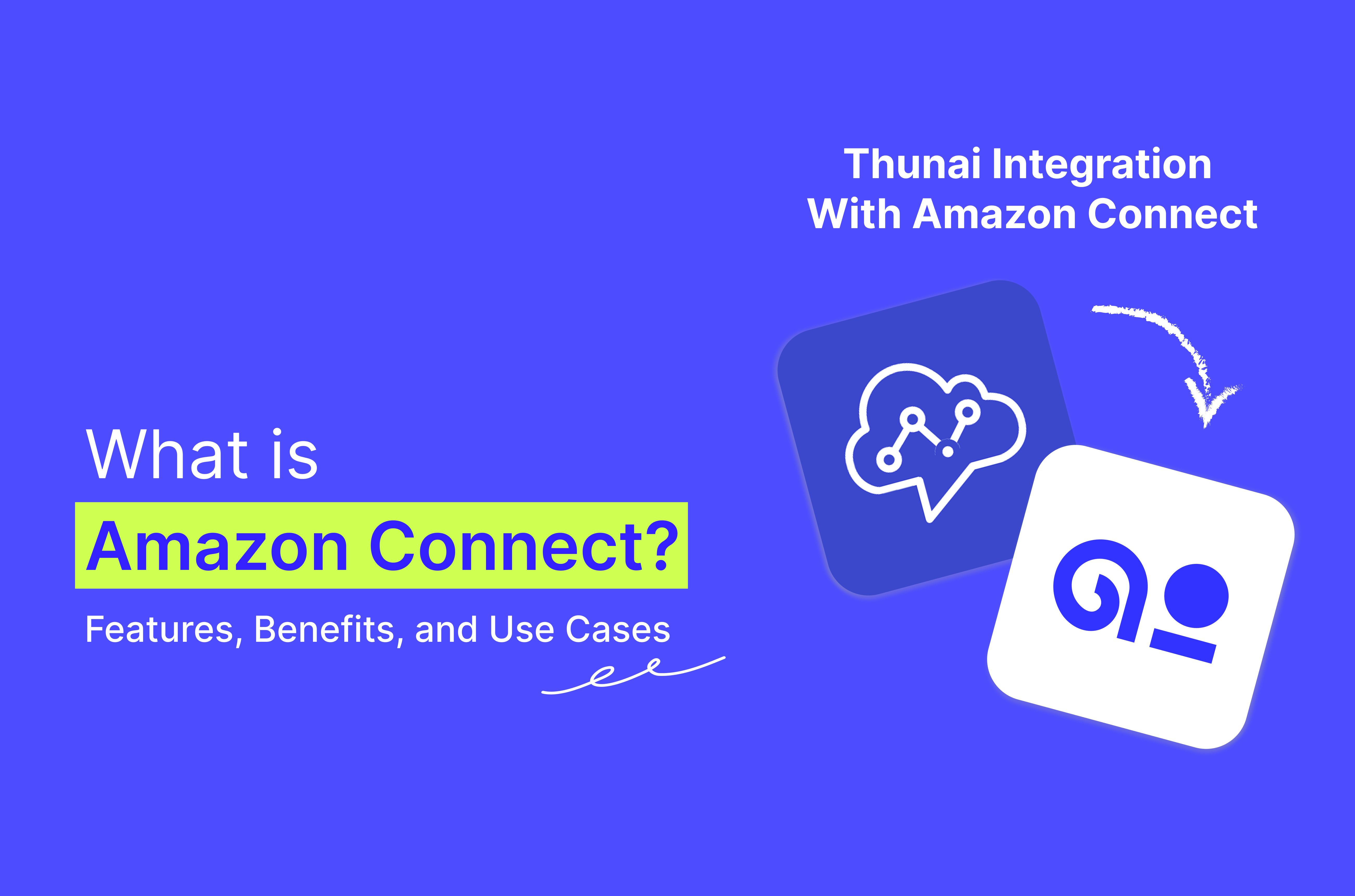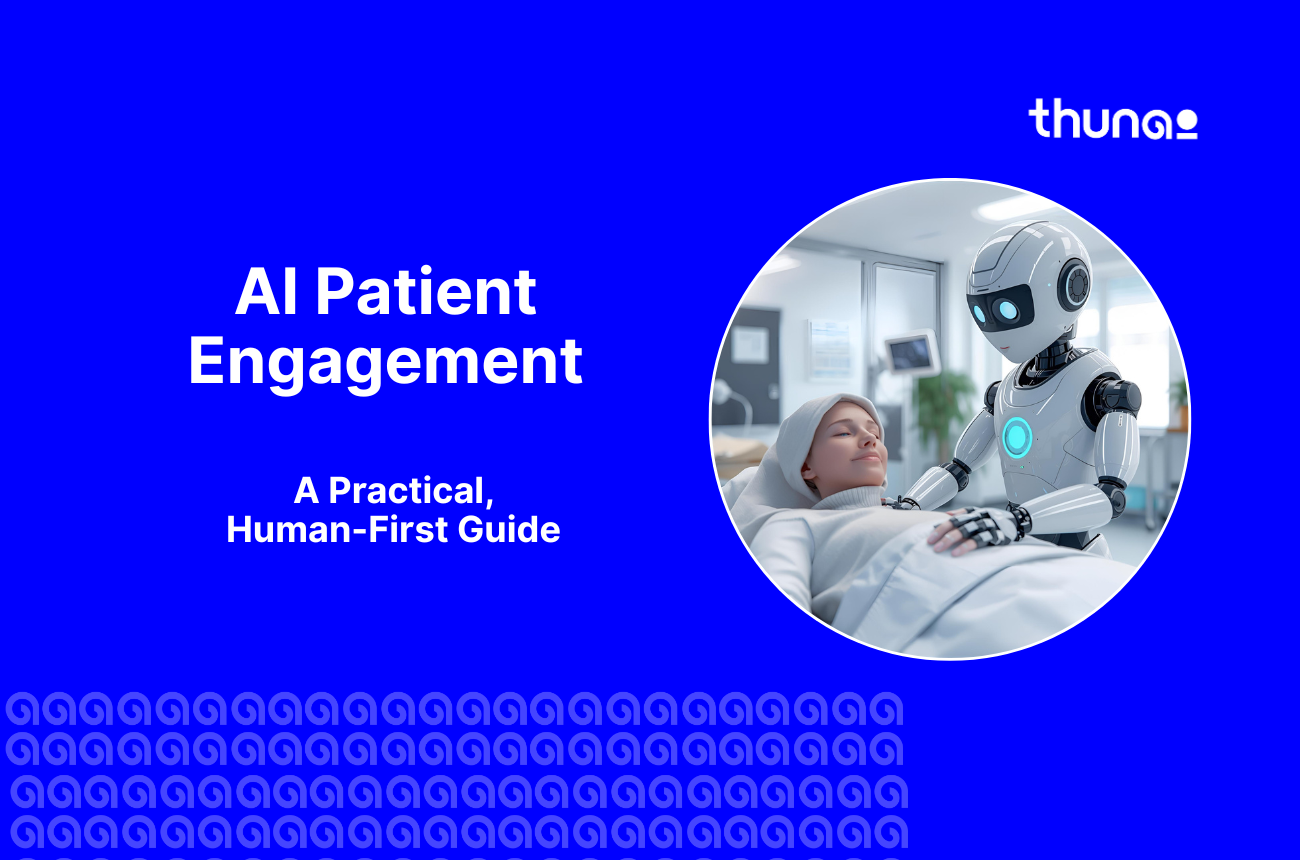

Thunai learns, listens, communicates, and automates workflows for your revenue generation team - Sales, Marketing and Customer Success.
- Amazon Connect is a flexible, pay-as-you-go cloud contact center from AWS that provides AI-powered, omnichannel support.
- Users can set up call handling through a simple drag-and-drop tool called Contact Flows.
- Amazon Connect offers its own generative AI tools: Amazon Q (live agent assistant for recommended responses and actions) and Contact Lens (AI analytics and call summarization).
- Connect's capabilities are greatly enhanced by Thunai, which adds human-like AI agents, a central knowledge hub, and 100% automated call auditing for deeper automation and insight.
Is your current contact center software too rigid?
Well, Amazon Connect presents a different, flexible, and affordable path for managing customer experience that many companies use right now.
This guide will walk you through its key features and primary benefits. We will also go over practical use cases.
What is Amazon Connect?
Amazon Connect is a Contact Center as a Service (CCaaS) platform. It allows businesses to set up and manage a customer contact center entirely in the cloud. Traditional systems call for significant hardware investment and fixed per-agent licensing.
Amazon Connect is different and was built within Amazon Web Services (AWS). Its purpose was to handle the immense scale and complexity of Amazon’s retail business. But it is now a major leader in the CCaaS market according to Forrester.
The platform's primary purpose is to make advanced contact center technology accessible to all businesses. It’s overall value is based on three foundational elements:
- AI-Powered Experiences: Artificial intelligence is central to the platform's design. It is incorporated across every workflow. This includes natural language chatbots and real-time agent assistance. It also features post-call analytics that find deep insights from customer conversations.
- Omnichannel by Design: The system was engineered from the beginning to supply a unified experience. This is true for both customers and agents. The experience is consistent across voice, chat, email, and other messaging platforms. This method gets rid of the operational silos common in older systems.
- Affordable Pricing Model: Its pay-as-you-go pricing model was a major shift for the industry. It did away with per-seat licensing fees and long-term contracts. This lets businesses pay only for what they use and scale on demand.
Key Features of Amazon Connect
Amazon Connect has a wide range of features. These features often work as interconnected services. This allows businesses to construct a solution specific to their operational needs.
Omnichannel Engagement
A central principle of the platform is its native ability to supply a unified experience. This experience is consistent across all customer touchpoints.
- High-Quality Voice: The platform delivers high-quality audio. It uses a WebRTC-based softphone in an agent's browser. AWS manages a global network of telephony suppliers. This takes away the complexity of carrier contracts.
- Digital Channels: Connect supplies a customizable chat widget for websites and mobile apps. It also has the ability to embed voice and video calling directly into a company's digital properties. Features like screen sharing can speed up issue resolution.
- Messaging and Email: Native connections for SMS, WhatsApp, and Apple Messages for Business are included. These permit agents to handle asynchronous conversations in the same unified workspace. Email is also treated as a primary channel with its own dedicated workflows.
AI-Powered Capabilities
The platform's strategic direction is its deep use of artificial intelligence. This is done to improve efficiency and gather insights. Aside from this, you can pair Amazon Connect with different AI-powered enterprise contact center software to improve its functionality.
- Amazon Q in Connect: This generative AI assistant works in real-time. It gives agents recommended responses and surfaces information from knowledge bases. It can also automatically put together summaries of conversations.
- Contact Lens Analytics: This is the platform's analytical engine. It transcribes calls and chats. It then applies natural language processing to find out insights. These can include customer sentiment and recurring issues.
- Natural Language Automation: The system connects closely with Amazon Lex. This allows for the creation of advanced conversational IVRs and chatbots. As a result, customers can interact using natural language instead of rigid menus.
.png)
How Amazon Connect Works
To understand Amazon Connect, one must look at its underlying architecture. It is not a single, monolithic application. Instead, it is a platform of powerful, interconnected services. Amazon Connect also helps track some agent performance metrics, although these can be a little general.
These services are designed to act as a central hub within the AWS ecosystem.
I. A Component-Based Architecture
- The platform’s design is made of distinct components. These can be assembled as needed. This allows a business to start with fundamental capabilities.
- Later, it can add advanced features, such as AI-driven analytics or case management. This design grants immense flexibility.
- However, it does require the customer to configure these components into a cohesive solution. The platform's API-first design means nearly every part can be programmatically controlled. This lets companies build out highly customized solutions.
II. The Role of Contact Flows
Central to this customization is the Contact Flow designer. It is a visual, drag-and-drop interface. It is used to create and manage the workflows that direct the contact center's logic.
- This single tool designs everything from customer-facing IVRs to internal agent routing. It even handles back-end automation.
- For advanced customization, flows can connect with AWS Lambda. This lets developers carry out custom code and interact with other systems.
Using the Thunai Integration With Amazon Connect For Better Customer Support Intelligence and AI Workflows
Amazon Connect provides a powerful, flexible foundation for a contact center.
However, its capabilities can be enhanced a lot more with a specialized AI solution like Thunai.
Thunai is a next-generation 'Agentic AI Platform' built for human-like automation.
This type of connection is made possible by Amazon Connect's API-first design and its ability to trigger external services.
By connecting the two platforms, businesses can move beyond standard automation to create a highly intelligent and efficient IT support operation.
How Thunai Improves Amazon Connect When Integrated:
- Human-Like AI Agents: Thunai allows you to create and deploy fully functional AI voice, chat, and email agents in minutes. These agents can be integrated directly into Amazon Connect's Contact Flows. This means a customer query can be first handled by a Thunai AI agent that uses a company's knowledge base to provide answers, and only if the issue is unresolved.
- Creating a Centralized Knowledge Hub: Thunai features the "Thunai Brain," a self-learning knowledge hub that can process scattered company data from documents, videos, and databases.
- Voice Agents with Screen Share: Thunai allows you to use AI voice agents that guide you through the process with a screenshare feature. Make customer support a lot more helpful and interactive.
- Intelligence Dashboards: Get intelligence on your agents' activity, status, as well as the details on escalations and the number of issues resolved in real time.
- Jira Service Desk Automation: Automate service tickets and Jira tickets using voice agents and email agents, so you can make sure support teams have faster issue turnaround and responses.
- Real Time Support for Agents: Within a Contact Flow, Amazon Connect can query this centralized brain. This gives both human agents using the Amazon Connect workspace and the automated AI agents access to a single, consistent source of information for resolving issues.
- Achieving 100% Quality Assurance on Calls: Thunai features automated call audits and AI call scoring, providing summaries, sentiment analysis, and performance metrics for all calls.
- Global Reach with Multilingual Support: Thunai's ability to support over 150 languages can be used to power AI agents across Amazon Connect's omnichannel platform. This allows a business to use a single, integrated solution to deploy sophisticated, automated support for its global user base
Primary Benefits of Using Amazon Connect
Market analysis and user feedback point to several key business advantages. These advantages drive companies to choose Amazon Connect.
1. Exceptional Scalability and Elasticity
The system is a cloud-native solution. It allows businesses to scale from a few agents to thousands on demand.
This is ideal for handling variable contact volumes, such as seasonal retail peaks. It does this without any need for hardware planning. This elasticity is a powerful advantage for any business with fluctuating demand.
2. A Cost-Effective Financial Model
The pay-as-you-go pricing model is a significant benefit. Users frequently cite the ability to avoid large upfront capital investments.
They also avoid fixed per-agent licensing fees. This greatly lowers the barrier to entry for using advanced technology. It also allows costs to be directly matched with actual usage.
3. Deep AWS Ecosystem Connection
Many companies are already invested in the AWS cloud. For them, the native connection is a clear advantage.
The platform works well with services like AWS Lambda for automation and Amazon S3 for data storage. This creates a cohesive and extensible technical environment.
4. An Intuitive Agent Interface
Many reviews highlight the simplicity of the agent-facing tools. The unified Agent Workspace is a good example.
It consolidates all necessary applications onto a single screen. It is widely regarded as clean, simple, and easy to learn. This focus on a modern user experience leads to higher productivity and satisfaction.
Common Use Cases for Amazon Connect
The platform's flexibility makes it suitable for a wide array of industries. Its architecture allows it to be shaped to fit specific operational and compliance needs.
- Retail and E-commerce: Stores use Amazon Connect for busy sales times, like holidays. They do not need to sign a contract for a full year. The system also has omnichannel support to customers by chat, email, and phone.
- Financial Services: Banks and insurance companies use Amazon Connect to make safe call centers. These call centers must follow the law. They are made to keep customer details safe. The system lets them control who can see information and have a clear record of it.
- Healthcare: Hospitals and clinics can make safe ways to talk with patients. These methods must follow HIPAA privacy rules. They often use Amazon Connect to book appointments or answer questions. A tool called Step-by-Step Guides helps workers follow difficult sign-up steps correctly.
- High-Growth Startups: New companies like Amazon Connect. It is easy to get started. A new business can start a call center without buying any equipment and can handle more work as the business gets bigger.
Automating Your Customer Support Using Thunai Paired With Amazon Connect
In this article, we’ve answered the question - what is Amazon Connect and why it’s so popular.
For businesses that use AWS services, the system can be very convenient. Using Thunai adds agents that act like people and gives detailed call information. It also lets you monitor agent activity as it happens.
Not to mention, there are features like meeting assistants and revenue AI. Email agents are also available to automatically answer customer questions and assist with scheduling sales calls.
Want to see how this works? Sign-up to Thunai for free!
FAQs on Amazon Connect
What is Amazon Connect Contact Lens Analytics?
Contact Lens for Amazon Connect is the system's analytical tool. It is used for quality management and conversation analysis. The tool creates text transcripts of calls and chats. It then uses natural language processing to identify information. This information includes customer feelings and patterns in conversations.
How does Amazon Connect use Amazon Lex?
Amazon Connect has a close connection with Amazon Lex. This integration is used to build advanced, conversational Interactive Voice Response (IVR) systems and chatbots. This lets customers communicate using normal language. They are not required to follow inflexible, menu-based choices.
How much does Amazon Connect cost?
Amazon Connect uses a pay-as-you-go payment model. There are no minimum fees or long-term contracts. The costs depend on actual use. Examples include per-minute charges for voice calls and per-message charges for chats.
What is an Amazon Connect agent?
An Amazon Connect agent is a person who handles customer communications. They use the system for interactions over voice and chat. Agents work mostly in the Agent Workspace. The Agent Workspace is a single, easy-to-use application and is the main screen they use for their work.
What is Amazon Q in Connect?
Amazon Q in Connect is the system's main generative AI assistant. It helps both agents and customers. For agents, it functions in real time to suggest responses. It also automatically creates summaries of conversations.






